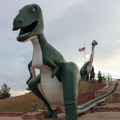Dinosaur Park is located on the summit of the Dakota Hogback, a land formation that essentially separates Rapid City into east and west halves. Known as the “Gateway to the Black Hills,” Rapid City sought to capitalize on the tourism industry that had thrived in the area since the 1920s and had increased dramatically after construction on Mount Rushmore began in 1927. In the early 1930s, the Rapid City Chamber of Commerce proposed a roadside attraction linked to the history of the area. Dinosaur prints had been discovered near the selected site, and fossil finds were widespread throughout South Dakota. The resulting park offers a distinct interpretation of the roadside colossus—five life-size dinosaur sculptures accessed via a scenic road.
Credit for the idea of dinosaur sculptures goes in part to C.C. O’Hara, a paleontologist and retired president of the South Dakota School of Mines and Technology, and in part to R.L. Bronson, the secretary of the Rapid City Chamber of Commerce. With funding from the Works Progress Administration, Dinosaur Park was begun in 1936. Sculptor Emmet Sullivan (1877–1970), who worked on Mount Rushmore, designed the dinosaurs using measurements from Barnum Brown, a curator at the American Museum of Natural History. Under Sullivan’s direction, twenty-five men framed the figures with iron pipe, formed the bodies of steel wire mesh, and applied a concrete skin with an average thickness of four to five inches. The five dinosaurs include a Triceratops, Tyrannosaurus Rex, Brontosaurus, Stegosaurus, and Apatosaurus. The 80-foot-long and 28-foot-high Brontosaurus stands at the highest point of the ridge, while the other dinosaurs line the steep flagstone stairs leading from the parking lot.
Once the park was completed, Sullivan and his wife, Lorraine, opened a concession stand (now a visitors’ center) facing the parking lot. The single-story rectangular building has a gabled roof that extends over the main facade, forming a veranda. Two additional sculptures, a Protoceratops and Dimetrodon, were added at a later date near the visitors’ center. The free public park is a popular tourist destination and a perennial favorite of local residents, especially children, who are allowed to climb the dinosaurs. The bright green sculptures are repainted regularly.
With advancements in research, natural history museums across the U.S. are updating their dinosaur displays; here, however, the dinosaurs remain frozen in time.






